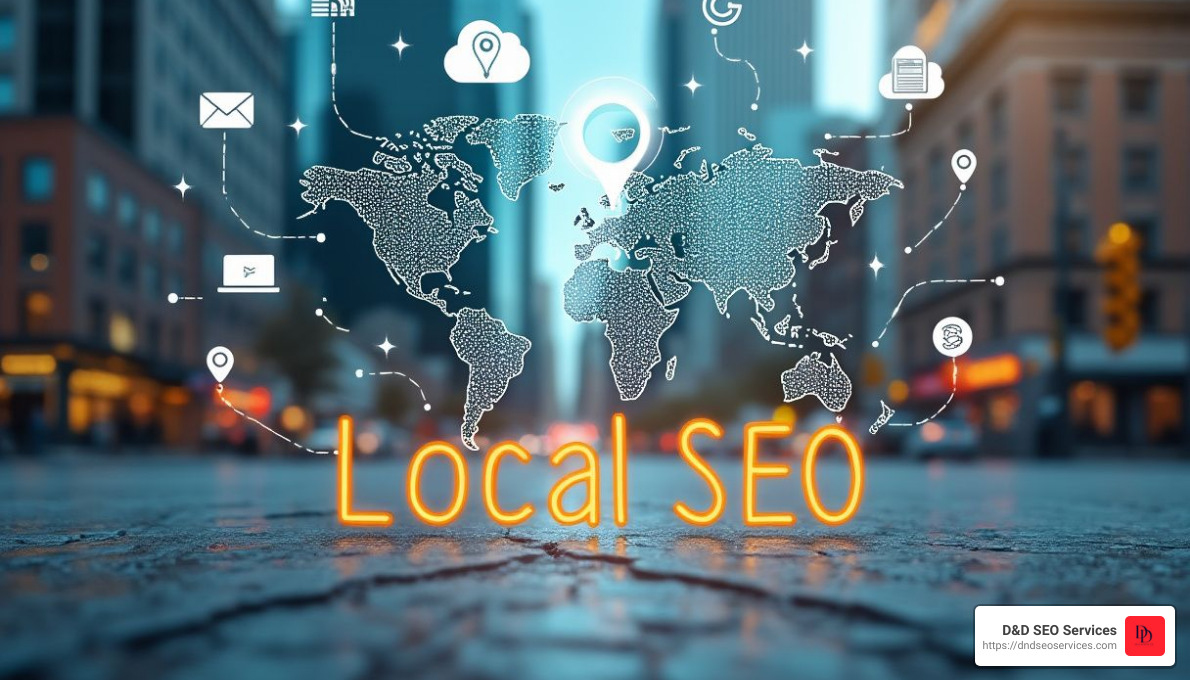Why Geofencing SEO is a Game-Changer for Local Businesses
Geofencing SEO is a remarkable strategy that integrates location-based services with search engine optimization to give local businesses a cutting edge in digital marketing. Curious about how it works? Here’s a quick rundown:
- Geofencing SEO uses GPS, RFID, Wi-Fi, and cellular data to create virtual boundaries around specific areas.
- When potential customers enter or exit these areas, they receive custom notifications, ads, and offers.
- This highly-targeted approach increases foot traffic, boosts online visibility, and improves customer engagement.
Geofencing SEO helps businesses connect with the right audience at the right time, ensuring higher conversion rates and better ROI.
I’m Danielle Birriel, founder of D&D SEO Services, with over a decade of experience in local SEO and digital marketing. My focus has always been on leveraging cutting-edge technology to help small businesses thrive. I believe that geofencing SEO is a powerful tool to drive more foot traffic and improve local search rankings for your business.
What is Geofencing?
Geofencing is a location-based service that leverages various technologies to create virtual boundaries around specific geographic areas. When someone enters or exits these predefined areas with their mobile device, certain actions are triggered, such as sending notifications or displaying ads.
How Does Geofencing Work?
Geofencing uses a mix of GPS, RFID, Wi-Fi, and cellular data to identify when a device crosses a virtual boundary. Think of it like an invisible fence that triggers an action when crossed.
For example, imagine you’re walking past a coffee shop. If the shop has set up a geofence, your phone might receive a notification about a special discount available only to people who are nearby. This is geofencing in action!
The Tech Behind Geofencing
- GPS (Global Positioning System): GPS satellites help pinpoint the exact location of a device. This is crucial for creating accurate geofences.
- RFID (Radio Frequency Identification): Often used in combination with GPS, RFID can help identify devices within a specific range.
- Wi-Fi: Wi-Fi networks can also be used to determine a device’s location, especially indoors where GPS signals might be weak.
- Cellular Data: Cell towers provide another layer of location data, useful for broader geofencing applications.
Virtual Boundaries
These technologies work together to establish virtual boundaries. When a device crosses these boundaries, it can trigger various actions, such as:
- Sending push notifications
- Displaying targeted ads
- Alerting businesses to a customer’s presence
Real-World Example
Imagine you own a country-themed bar. You can set up a geofence around a nearby concert venue that hosts country music events. When concertgoers leave the venue, they might receive a notification about a special offer at your bar. This is a perfect example of how geofencing can attract customers who are already interested in what you offer.
Geofencing is a powerful tool that can help businesses connect with potential customers at the right place and time, making marketing efforts more effective and efficient. By understanding and utilizing this technology, you can significantly improve your local SEO and drive more foot traffic to your business.
Next, let’s explore how geofencing SEO can improve local search and improve your marketing strategy.
How Geofencing Works
Geofencing leverages real-time spatial analysis to interact with users based on their location. Think of it as drawing a virtual boundary around a specific area, like your store or a competitor’s shop. When a user with a mobile device crosses this boundary, it triggers a predefined action, such as sending a notification or displaying an ad.
Real-Time Spatial Analysis
Real-time spatial analysis is the backbone of geofencing. This technology uses GPS, Wi-Fi, and cellular data to pinpoint a user’s location instantly. When a user enters or exits a geofenced area, the system responds immediately. This allows businesses to engage with customers at the exact moment they are near your location.
Mobile Networks
Geofencing relies heavily on mobile networks. These networks help track user locations and deliver notifications or ads. By using mobile data, businesses can ensure that their messages reach users wherever they are, whether they’re shopping, commuting, or just walking around.
Notifications
When a user enters a geofenced area, they receive notifications on their mobile device. These can be push notifications, SMS messages, or in-app alerts. For example, a coffee shop might send a notification offering a discount to users who are within a one-mile radius. This instant communication makes it easier to attract nearby customers.
Personalized Ads
Personalized ads are another key feature of geofencing. By understanding a user’s location and behavior, businesses can deliver highly targeted ads. For instance, if someone frequently visits gyms, they might receive ads for nearby fitness centers when they are in the area. This level of personalization increases the chances of converting leads into customers.
User Proximity
User proximity is crucial for the effectiveness of geofencing. The closer a user is to your business, the more likely they are to respond to your marketing efforts. Setting a geofence within a five-minute walking distance from your store can significantly boost foot traffic and sales.
By combining these elements, geofencing creates a powerful synergy that improves local SEO and marketing strategies. Businesses can reach their target audience more effectively, resulting in higher engagement and better ROI.
Next, let’s explore how geofencing SEO can improve local search and improve your marketing strategy.
Geofencing SEO: Enhancing Local Search
Geofencing SEO is a game changer for local businesses. It combines the power of geofencing technology with SEO strategies to target customers based on their location. This method helps businesses engage customers more effectively and boost their local search visibility. Let’s dive into the benefits and how to implement geofencing SEO.
Benefits of Geofencing SEO
Precise Targeting
Geofencing allows businesses to create virtual boundaries around specific locations. When a potential customer enters this area, they receive targeted ads or notifications. This precise targeting ensures your message reaches the right people at the right time.
Efficiency
By focusing on a specific geographic area, geofencing reduces wasted ad spend. You’re not paying to reach people who are unlikely to visit your store. This makes your marketing budget more efficient.
Effectiveness
Geofencing SEO provides valuable data on customer behavior. You can track how long customers stay in your store, what they look at, and whether they make a purchase. This data helps refine your marketing strategies for better results.
Data Collection
With geofencing, you gather real-time data on customer interactions. This includes metrics like ad impressions, click-through rates, and conversions. Analyzing this data helps you understand what works and what doesn’t.
Attribution
Geofencing bridges the gap between online ads and offline actions. You can see when a customer viewed an ad and whether they visited your store. This helps determine the true ROI of your marketing efforts.
How to Implement Geofencing SEO
Use IP Addresses and GPS
Geofencing relies on technology like IP addresses and GPS to track customer locations. Ensure your business app or website can access these features to activate geofencing.
Guides and Search Analysis
Use search analysis to understand what your potential customers are looking for. This helps in crafting relevant ads and offers. For example, if people are searching for “best coffee near me,” a coffee shop can target these searches with special offers.
Understand Demographics
Know your audience. Research their preferences, behaviors, and needs. This information helps create effective geofencing boundaries and personalized messages.
Set Clear Goals
Before launching a geofencing campaign, set SMART goals (Specific, Measurable, Achievable, Relevant, Time-bound). This ensures you have a clear direction and can measure success.
Craft Effective Messaging
Your ads should be clear and actionable. Include a strong call to action (CTA) that encourages immediate response. For example, “Visit us today for a 10% discount!”
Monitor and Adjust
Track the performance of your geofencing campaigns regularly. Use the data collected to make necessary adjustments. This could involve changing the geofence boundaries, tweaking the ad content, or targeting a different demographic.
By following these steps, you can effectively implement geofencing SEO and improve your local search strategy. This approach not only improves customer engagement but also maximizes your marketing ROI.
Next, we’ll look at some practical applications of geofencing SEO and how businesses are using it to their advantage.
Practical Applications of Geofencing SEO
Case Studies
Geofencing SEO is a powerful tool that can be used in a variety of ways to boost your local search strategy. Let’s look at some real-world examples and case studies to see how businesses are leveraging this technology.
Location-Based Offers
One of the most effective uses of geofencing SEO is to send location-based offers to potential customers. For instance, a local coffee shop might use geofencing to send push notifications with special promotions to users who are near their location. This strategy not only attracts customers but also encourages repeat visits.
Audience Nurturing
Geofencing can also be used to nurture your existing audience. By setting up geofences around your own store locations, you can encourage reward program sign-ups, social media follows, and more. This keeps your customers engaged and loyal. For example, a fitness center might send a push notification offering a free training session to members who are near the gym but haven’t visited in a while.
Real-World Examples
Small Businesses: Even small businesses can benefit from geofencing SEO. A regional senior care center used geofencing to target emergency rooms, hospitals, and competing care facilities. This resulted in 60 walk-ins and tours over a 30-day period.
Fitness Centers: A gym targeted competing fitness centers to boost memberships. This campaign led to 73 new extended memberships, generating approximately $38,000 in revenue.
Hotels: A hotel used geofencing to target other hotels in the area for staff recruitment. This strategy resulted in 60 applications and a 20% capacity increase.
These examples clearly show how versatile and effective geofencing SEO can be for businesses of all sizes. Whether it’s attracting new customers, stealing competitors’ customers, or nurturing your existing audience, geofencing offers numerous opportunities for growth.
Best Practices for Geofencing SEO
Setting Goals
Before diving into your geofencing SEO campaign, it’s crucial to set clear goals. Specific, Measurable, Attainable, Relevant, and Time-bound (SMART) goals will guide your strategy and help you measure success.
Example:
– Increase in-store visits by 20% within three months.
– Boost local search traffic by 15% in the next quarter.
These goals should be aligned with your overall business objectives. Use measurable metrics like click-through rates (CTR), conversion rates, and foot traffic to track progress.
Understanding Your Audience
Knowing your audience is the foundation of any successful geofencing SEO campaign. Use tools like Semrush’s One2Target to analyze demographics, socioeconomics, and behavior.
Key Areas to Focus On:
– Demographics: Age, gender, location.
– Behavior Analysis: Interests, shopping habits.
– Social Media Insights: Preferred platforms, engagement levels.
By understanding who your customers are and what they want, you can tailor your messaging to resonate with them.
Crafting Effective Messaging
The right message at the right time can significantly impact your campaign’s success. Your ads should be clear, relevant, and have a strong call to action (CTA).
Tips for Effective Messaging:
– Relevancy: Ensure the message aligns with the audience’s needs and interests.
– Clarity: Keep the message simple and to the point.
– Call to Action: Use engaging CTAs like “Visit Now” or “Get 20% Off Today.”
For example, Sephora’s Store Companion app alerts customers about available wish-list items and special offers as soon as they enter the store, enhancing customer loyalty and satisfaction.
Setting Geofence Boundaries
Choosing the right size for your geofence is crucial. A geofence that’s too large can waste your budget, while one that’s too small might miss potential customers.
Best Practices:
– Start Small: Test with a smaller area and expand based on performance.
– Target Relevant Areas: Focus on locations where your target audience is likely to be.
For instance, a small boutique might focus on the surrounding neighborhood, while a university might target a larger area to reach prospective students.
Campaign Launch
When launching your geofencing SEO campaign, you have three main options:
1. Do It Yourself: Use platforms like Google Ads or Meta Ads Manager.
2. Work with a Developer: Build a custom app with geofencing capabilities.
3. Partner with an Agency: Leverage their expertise and resources.
Each method has its pros and cons, so choose based on your resources and goals.
Example:
– Van Leeuwen: Used PayPal’s app to track users’ locations and offer deals, boosting foot traffic.
Analyzing and Optimizing
Once your campaign is live, continuous optimization is key. Use data to refine your approach and improve results.
Metrics to Track:
– View-Through Visits: Measure how many people saw the ad and visited later.
– Cost Per Visit (CPV): Evaluate the cost-effectiveness of your campaign.
– Click-Through Visits: Track immediate responses to your ads.
A/B testing can also help identify the most effective elements of your campaign. Test different messages, CTAs, and geofence sizes to find what works best.
By following these best practices, you can open up the full potential of geofencing SEO and drive meaningful results for your business.
Next, we’ll answer some frequently asked questions about geofencing SEO.
Frequently Asked Questions about Geofencing SEO
Can You Geofence SEO?
Absolutely! Geofencing SEO combines the power of geofencing with search engine optimization to improve local search efforts. By setting up virtual boundaries (geofences) around specific areas, businesses can deliver targeted ads to users’ mobile devices when they enter these zones. This means you can reach potential customers at the right place and time, improving your customer engagement and increasing the chances of conversion.
For example, a local coffee shop can set up a geofence around its location and send promotions to users nearby. This targeted approach ensures that the ads are relevant, leading to higher engagement and better ROI.
What is Geofencing in GIS?
Geofencing in GIS (Geographic Information Systems) involves creating a virtual perimeter around a real-world location. When a device enters or exits this boundary, specific actions are triggered. This technology uses real-time spatial analysis to monitor and track points within the defined area.
Imagine a fitness center setting up a geofence around a nearby park. When someone with a fitness app enters the park, they receive a notification about a special offer at the fitness center. This location-based offer can drive more foot traffic to the business and improve customer engagement.
What is the Purpose of Geofencing?
The primary purpose of geofencing is to deliver personalized content and location-based offers to users based on their physical location. This approach increases the relevance of the ads, leading to higher engagement and conversion rates.
Here are some key benefits:
- Increased Foot Traffic: By targeting users who are near your business, you can drive more people to visit your store.
- Improved Customer Engagement: Personalized messages and offers make users more likely to interact with your brand.
- Effective Local Search Optimization: Geofencing helps improve your visibility in local search results by targeting users in specific areas.
For instance, a hotel can set up geofences around nearby tourist attractions. When tourists enter these areas, they receive notifications about special room rates. This not only boosts bookings but also improves the overall customer experience.
By understanding and leveraging geofencing SEO, businesses can create more effective marketing campaigns that resonate with their target audience.
Next, we’ll look at some real-world examples and case studies to see how geofencing SEO works in practice.
Conclusion
At D&D SEO Services, we understand the power of combining geofencing SEO with local search strategies. Our personalized approach helps businesses tap into the full potential of location-based marketing. By targeting specific areas and optimizing for local searches, we ensure you reach your ideal customers at the right time and place.
Local SEO
Local SEO is more important than ever. According to D&D SEO Services, 97% of search engine users look online to find a local business. We help you dominate local search results, making your business easily found by potential customers in your area. From optimizing your Google Business Profile to building local citations, we make sure your business stands out.
AI-Driven Solutions
Artificial Intelligence (AI) is revolutionizing digital marketing. Our AI-driven solutions analyze user behavior, optimize ad placements, and refine targeting strategies. This ensures your campaigns are not only effective but also efficient. With AI, we can predict trends and adapt quickly, keeping you ahead of the competition.
Business Growth
Our ultimate goal is to drive business growth for our clients. We achieve this by focusing on both short-term wins and long-term strategies. Whether it’s optimizing your website for conversions or implementing effective content marketing, we ensure every aspect of your digital presence is fine-tuned for success.
Online Visibility
Good online visibility is crucial for any business. Our team uses cutting-edge optimization techniques to improve your website’s performance. By integrating tools like Google Analytics and VWO’s heatmap generator, we track user behavior to understand what works and what doesn’t. This data-driven approach allows us to make informed decisions that improve your online presence.
Why Choose D&D SEO Services?
With over a decade of specialization in SEO and digital marketing, D&D SEO Services stands as a trusted partner for businesses looking to lift their online presence. Our comprehensive approach ensures you not only reach your target audience but also engage and convert them.
Ready to open up the power of optimization techniques for your business? Contact us today to get started on your journey to online success!
By integrating these strategies, we help you create a stronger digital narrative that resonates with your audience, fostering growth and sustained customer relationships.








